Dell Precision M6700 Notebook Review: The Enterprise Split
by Dustin Sklavos on December 12, 2012 7:43 PM ESTApplication and Futuremark Performance
The Intel Core i7-3920XM CPU that powers our Dell Precision M6700 review unit isn't just the fastest notebook CPU we've tested, it's also potentially as fast as a desktop Ivy Bridge processor. At the same time, the NVIDIA Quadro K5000M is based on the fastest mobile gaming GPU currently available, and the M6700 is also enjoying a Samsung PM830 SSD as its system drive. All told, this should be the fastest notebook we've tested thus far.
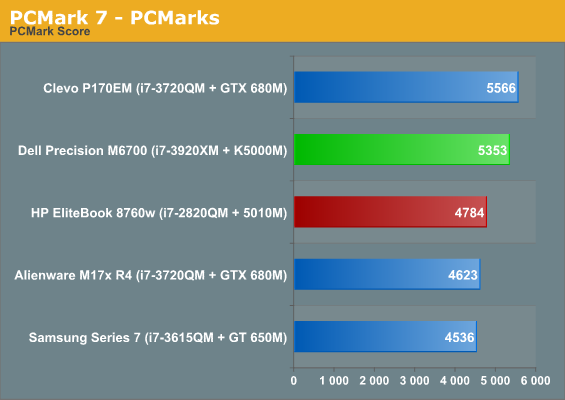

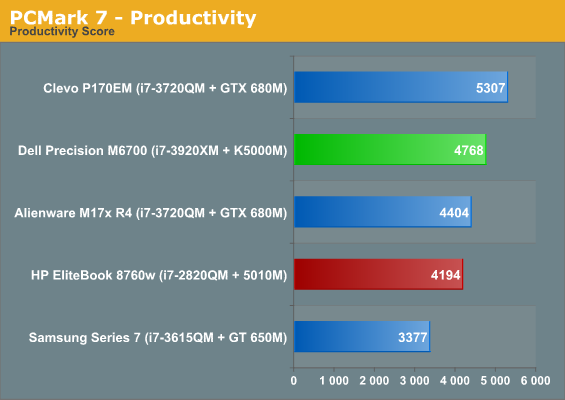
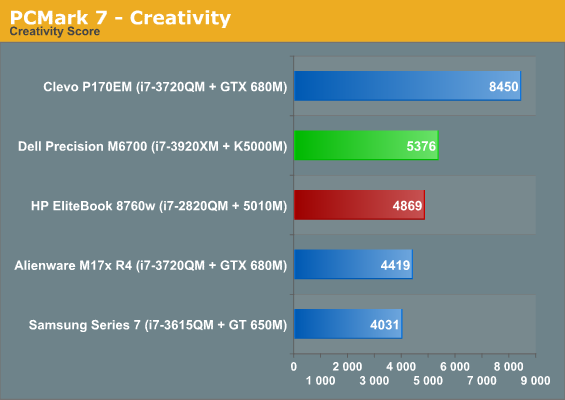
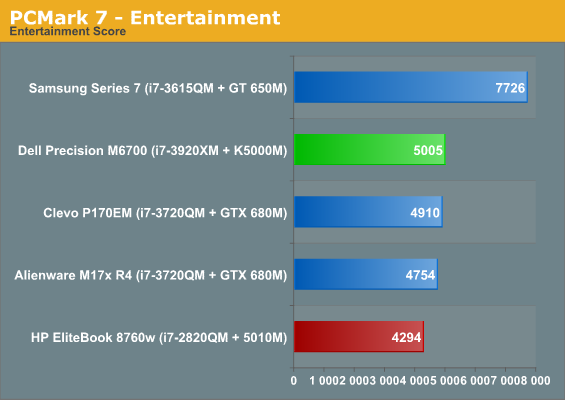
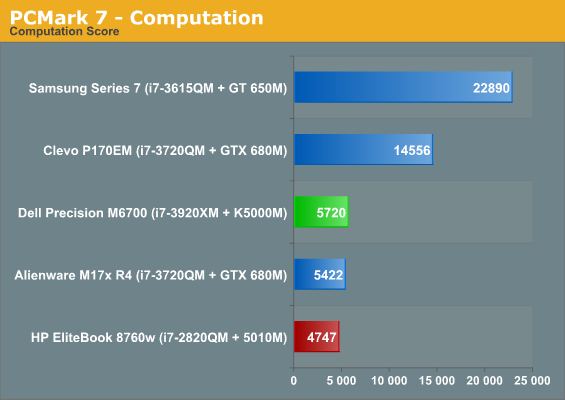
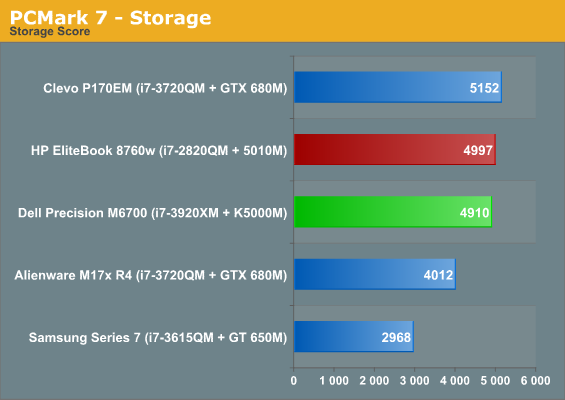
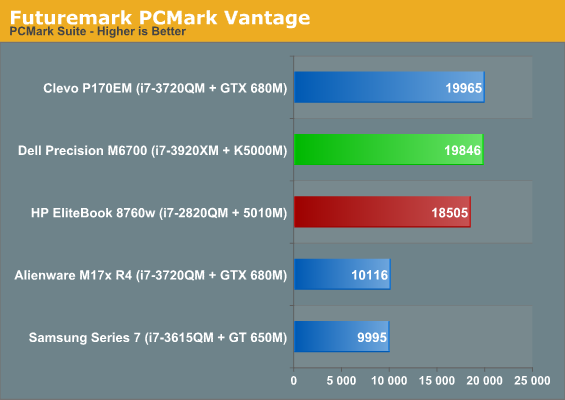
So what happened? It looks like PCMark slightly favors the Crucial m4 SSD the Clevo notebook uses. That's unfortunate, and frustrating, as once again PCMark shows it skews so hard towards the SSD that a system with a substantially more powerful CPU (lack of access to QuickSync notwithstanding), the Dell Precision M6700, is somehow eclipsed by a gaming notebook. But then I've been campaigning to remove PCMark from our testbed for some time now.
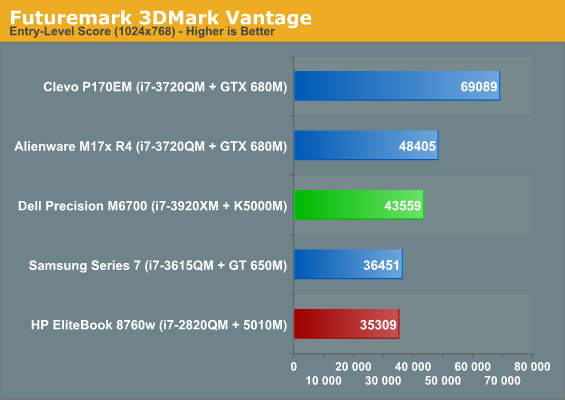
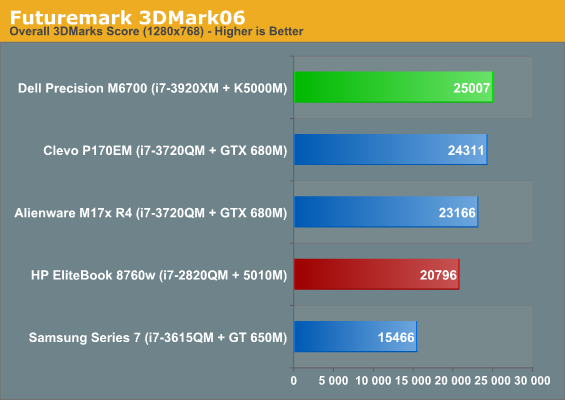
3DMark06 at least reveals the substantial performance of the i7-3920XM.
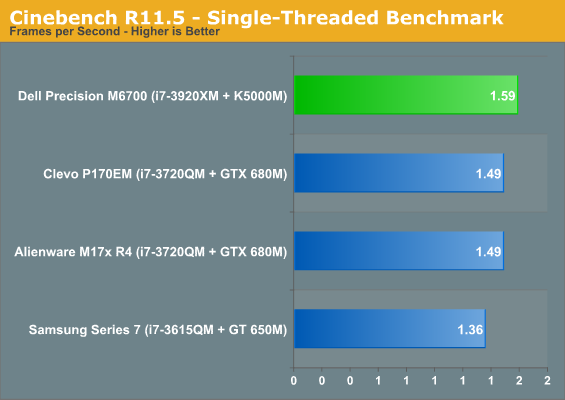
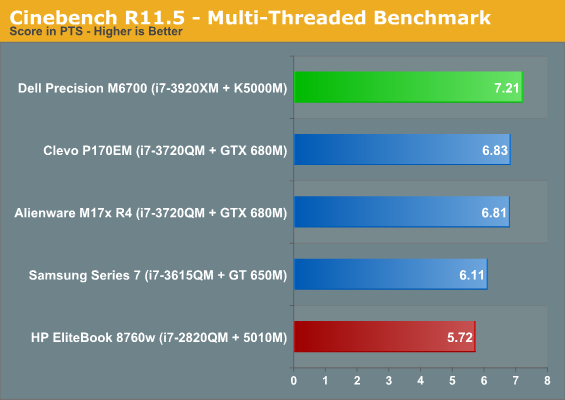
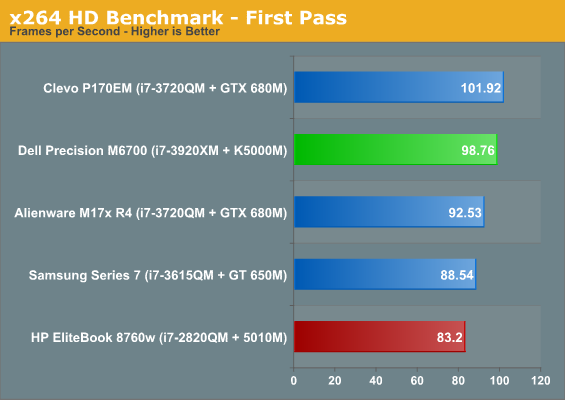

Inexplicably, Clevo's P170EM is able to produce better first pass results in our x264 benchmark, but in all other cases the M6700 is faster. For comparison sake, a stock i7-3770K (the one in the HP h9 Phoenix) is able to produce 100fps in the first x264 pass and 40.51fps in the second; that means that Intel's fastest (well, second-fastest now that the i7-3940XM is available) mobile chip is actually able to nip the heels of their fastest mainstream desktop chip. That also means that the 100MHz bump to the 3940XM is probably enough to get it to 3770K-level performance, which is frankly astonishing.










125 Comments
View All Comments
hrrmph - Thursday, December 13, 2012 - link
WiFi-ac?More crickets.
-
p05esto - Thursday, December 13, 2012 - link
And in a couple years where there WIFI-ac routers and services on the market I'm sure the M6900 will support it. Right now, totally not needed. Are you an Apple sheep or soemthing?critical_ - Friday, December 14, 2012 - link
Does anyone make half-length mini-PCIe 3x3 (or greater) 802.11ac cards these days? Last I checked there isn't one BUT once there is replacing the wireless card in the M6700 shouldn't be tough.hrrmph - Friday, December 14, 2012 - link
Good point.For what its worth, WiFi-ac is the only one of these subjects that I have any sympathy for the manufacturers on.
It is THIS year's nascent technology. Its hard, but not impossible to get this year's new tech onto a machine.
I use the laptop at home primarily, and infrequently in the field.
In the field I need autonomy for up to 2 months at a time, sometimes in very far flung places with little else available infrastructure-wise besides mains power and maybe 3G or 2G GSM. Hence the obsession with local storage, but I digress.
At home, I have ADSL.
The NetGear WiFi-ac router R6300 is available now at Amazon. I think it is 3 x 3 so you might get close to Gigabit WiFi speeds, or in actual practice, maybe 75% of Gigabit WiFi speeds. That's a very impressive boost over WiFi-n.
The equivalent NetGear ADSL Gateway Modem with built in WiFi-ac Router is the D6300. It is currently available at Amazon UK and should be available stateside any day now.
WiFi-ac is today's reality. Why buy an uber-expensive laptop this year when next year's model will have wireless that is 5 times faster...
Unless you want to gamble on the upgrade working.
I hope that you are correct that these machines can be upgraded from WiFi-n to WiFi-ac with a simple mini-card replacement.
But, when I tried to upgrade my existing ancient HP 17" from WiFi-g to WiFi-n, it didn't work. So I emailed HP and asked why. They said that for the newer WiFi-n mini-cards to be compatible, the BIOS needed to be changed and that HP wasn't willing to issue the necessary BIOS revision.
Granted my machine isn't a mobile workstation (it is one grade below that). I would hope that in the future if I pony up the cash for a mobile workstation class machine, that the manufacturers would be more accommodating with BIOS revisions than what I've experienced with the "desktop replacement" class laptop that I have now.
-
ShieTar - Friday, December 14, 2012 - link
So? You connect to your own company network by cable anyways, and if you are traveling, what are the chances that even if you find a WiFi-ac connection that there is an Internet-Connection behind it that is actually fast enough to utilise -ac speeds?hrrmph - Thursday, December 13, 2012 - link
UEFI capable BIOS?What happens when drives exceed 2TB capacity. Is the Dell machine stuck? Or does it have UEFI so that it can keep on keepin' on?
Th HP has it. I presume the Dell does too and the reviewer just didn't mention it. Still, it would be nice to know.
Dell's website on the subject of UEFI: Silent.
-
critical_ - Thursday, December 13, 2012 - link
Yes it is UEFI, has Secure Boot, etc.hrrmph - Thursday, December 13, 2012 - link
Sounds like the IPS panels are troublesome.Also, both Dell and HP make you drop extra equipment like the telephony SIM slots and GPS capabilities if you choose the IPS displays.
So how much Adobe RGB gamut do we give up if we downgrade to the non-IPS panels?
For graphics non-pros would it be noticeable? Annoyingly so?
-
critical_ - Thursday, December 13, 2012 - link
I am a M6700 owner. The IPS display causes the loss of Optimus. This is due to the display chain being pure 10-bit throughout which the Intel HD 4000 can't do.As far as SIM slots and GPS goes... Dell's online configuration tool won't allow you to add these but they all come with a SIM slot and antenna leads for a WWAN (and GPS) module regardless of the screen you pick can be added separately. I'm running the Dell 5630 (Gobi 3000) without any issues that I added myself.
hrrmph - Thursday, December 13, 2012 - link
Bummer on battery life...Anyone want to guess if Haswell fixes this?
I'm guessing not, unless Intel redesigns the EUs.
------------------------------------
Sweet! on SIM and GPS.
Just to be clear:
Is the SIM slot full-sized? (I hate to even ask, knowing it must be, but you just never know what you aren't being told when you buy something)
Are the antennas themselves already installed?
If not, did they come with the Dell 5630 card?
Thx
-